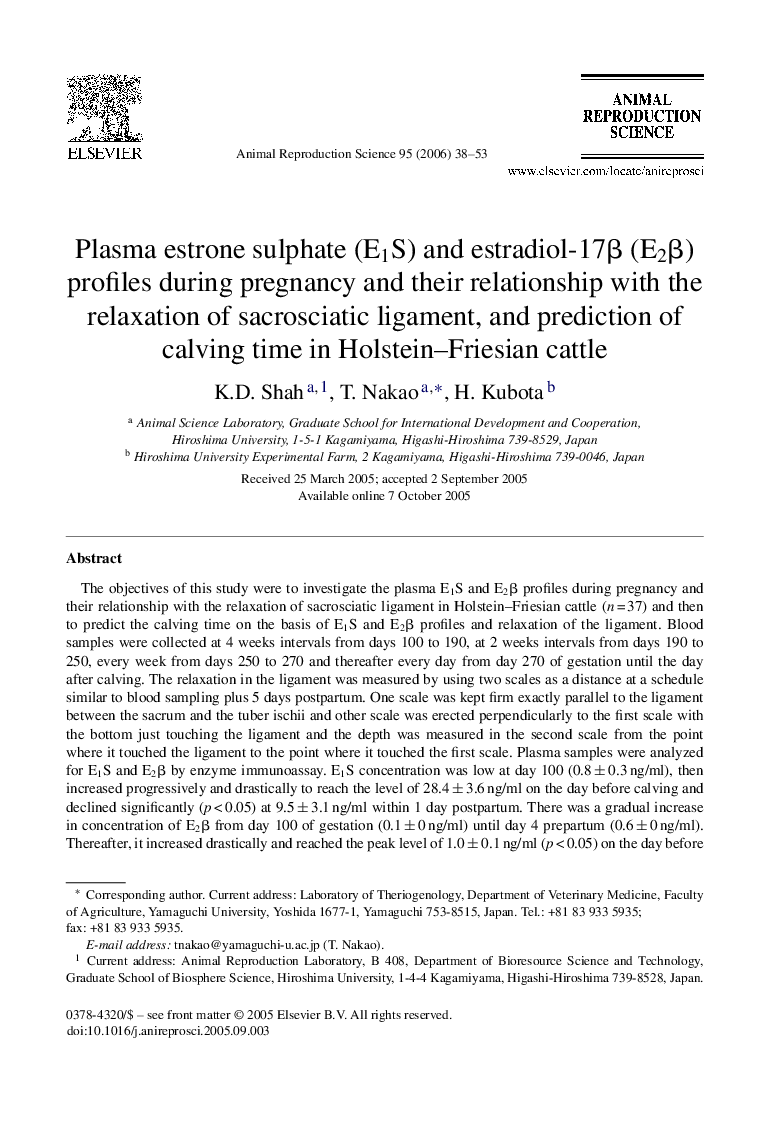| کد مقاله | کد نشریه | سال انتشار | مقاله انگلیسی | نسخه تمام متن |
|---|---|---|---|---|
| 2074844 | 1544826 | 2006 | 16 صفحه PDF | دانلود رایگان |

The objectives of this study were to investigate the plasma E1S and E2β profiles during pregnancy and their relationship with the relaxation of sacrosciatic ligament in Holstein–Friesian cattle (n = 37) and then to predict the calving time on the basis of E1S and E2β profiles and relaxation of the ligament. Blood samples were collected at 4 weeks intervals from days 100 to 190, at 2 weeks intervals from days 190 to 250, every week from days 250 to 270 and thereafter every day from day 270 of gestation until the day after calving. The relaxation in the ligament was measured by using two scales as a distance at a schedule similar to blood sampling plus 5 days postpartum. One scale was kept firm exactly parallel to the ligament between the sacrum and the tuber ischii and other scale was erected perpendicularly to the first scale with the bottom just touching the ligament and the depth was measured in the second scale from the point where it touched the ligament to the point where it touched the first scale. Plasma samples were analyzed for E1S and E2β by enzyme immunoassay. E1S concentration was low at day 100 (0.8 ± 0.3 ng/ml), then increased progressively and drastically to reach the level of 28.4 ± 3.6 ng/ml on the day before calving and declined significantly (p < 0.05) at 9.5 ± 3.1 ng/ml within 1 day postpartum. There was a gradual increase in concentration of E2β from day 100 of gestation (0.1 ± 0 ng/ml) until day 4 prepartum (0.6 ± 0 ng/ml). Thereafter, it increased drastically and reached the peak level of 1.0 ± 0.1 ng/ml (p < 0.05) on the day before calving and declined markedly at 0.4 ± 0.1 ng/ml within 1 day postpartum (p < 0.05). Corresponding to E1S and E2β concentrations, a gradual increase in the relaxation of the ligament was observed from day 100 of gestation (8 ± 1 mm) until day 2 prepartum (24 ± 2 mm). Thereafter, it showed a significant increase (p < 0.05) within 1 day before calving (31 ± 2 mm) and almost no difference between day 1 prepartum and day 1 postpartum. A marked decrease (p < 0.05) was observed thereafter until day 3 postpartum (10 ± 2 mm) and no significant change between days 3 and 4 as well as 4 and 5 postpartum. The increment of E2β by ≥0.20 ng/ml from the preceding day concentration was 85.2% accurate for predicting calving within 24 h in many of the cows (23 of 37) in the herd. The increment in ligament relaxation measurement by ≥5 mm from the preceding day measurement was the most efficacious to predict calving within 24 h with the highest accuracy (93.9%) in high proportions of cows (31 of 37) in the herd. In conclusion, plasma E1S and E2β concentrations and relaxation of sacrosciatic ligament increased gradually as gestation advanced and reached the peak level on the day before calving. The relaxation in the ligament corresponded well to plasma E2β concentrations. Prediction of calving was possible by E2β profile and relaxation in the ligament but not by E1S profile. The increment in ligament measurement by ≥5 mm from the preceding day measurement was the most useful and accurate in predicting calving within 24 h. It is economical and easily applicable in the field condition.
Journal: Animal Reproduction Science - Volume 95, Issues 1–2, September 2006, Pages 38–53